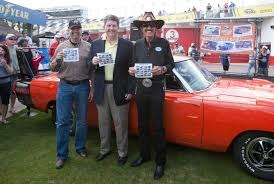 Raw power has a stamp of its own as seven-time NASCAR National Champion Richard Petty helped dedicate the ‘America on the Move: Muscle Cars Forever’ stamps.
Raw power has a stamp of its own as seven-time NASCAR National Champion Richard Petty helped dedicate the ‘America on the Move: Muscle Cars Forever’ stamps.
Petty, his son Kyle and Postmaster General Patrick Donahoe together dedicated the limited-edition stamps at the Daytona International Speedway where “The King” won a record seven Daytona 500 Championships.
Typically equipped with big, powerful engines, these high-performance vehicles began roaring across America in the 1960s. The limited edition stamps feature five iconic muscle cars: the ’66 Pontiac GTO, the ’67 Shelby GT-500, the ’69 Dodge Charger Daytona, the ’70 Plymouth Hemi ’Cuda and the ’70 Chevelle SS.
Richard Petty gave his "stamp of approval," saying the muscle cars stamps celebrate an exciting era in American automotive history.
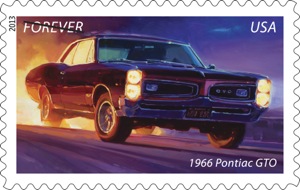 “These examples of raw power bring back fond memories for me and my family, a testament to how aerodynamics transformed racing. I’ve been around racing and muscle cars all my life. These stamps bring back the memories of our racing heritage in the ‘60s and ‘70s. This is a great way to share our stories, old and new, about the Petty history in racing.”
“These examples of raw power bring back fond memories for me and my family, a testament to how aerodynamics transformed racing. I’ve been around racing and muscle cars all my life. These stamps bring back the memories of our racing heritage in the ‘60s and ‘70s. This is a great way to share our stories, old and new, about the Petty history in racing.”
“The muscle cars gave everyday Americans the opportunity to experience the rush of driving a fast, powerful car,” said Donahoe. “Just looking at the stamps evokes a feeling of speed. As Forever stamps, they’ll always be good for mailing a First-Class letter anytime in the future. And when you think about it, that’s fitting. Because these stamps—just like the great cars they represent—are timeless.”
The Muscle Cars Forever stamps are the third issuance in the “America on the Move” stamp series. The artwork was created by Tom Fritz of Newbury Park, CA, under the art direction of Carl T. Herrman of North Las Vegas, NV. Other issuances in the series, ’50s Sporty Cars (2005), followed by ’50s Fins and Chrome (2008), were the work of artist Art Fitzpatrick of Carlsbad, CA.
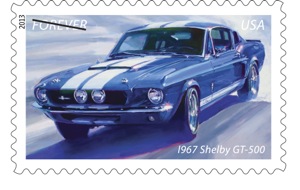
About the artist: Tom Fritz
Fritz, who’s art developed from his early years as a gearhead, was raised in San Fernando, CA, riding the crest of the baby-boomer wave.
“It was there, one morning, that I discovered that the alluring aroma of Crayola crayons was powerfully linked to the unlimited potential of making a mark.
"It was there and then that I began my lifetime passion of mark-making. I was a normal kid, filling reams of paper with my version of dinosaurs, fighter aircraft, motorcycles, tanks, machine guns, battleships, and war scenes instead of doing my homework.”
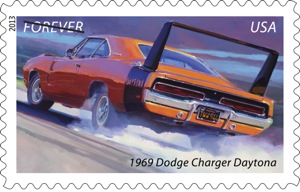 Running in parallel with his blossoming artistic endeavors, young Fritz also developed a deep love for metal making noise. “I spent much time with my father in the garage when he was working on the old woody wagon or the ’56 Chevy,” he said.
Running in parallel with his blossoming artistic endeavors, young Fritz also developed a deep love for metal making noise. “I spent much time with my father in the garage when he was working on the old woody wagon or the ’56 Chevy,” he said.
“I loved the tools the way they felt in the hand and the music they made when they were dropped. To this day, I still have an appetite for the aroma of gasoline, exhaust, grease, and WD-40. So it was natural that I started to explore the automobile as a source of expression in my art.
When Fritz was 14, he began to build a ’23 T-bucket roadster with the idea that he could drive it when he turned 16.
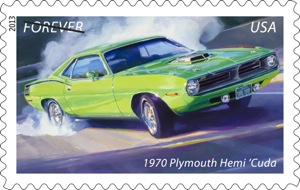 “I acquired a used Chevy 283 engine, tore it apart, and proceeded to rebuild it in an engine stand designed by my father, but hacksawed and welded together by me,” he said.
“I acquired a used Chevy 283 engine, tore it apart, and proceeded to rebuild it in an engine stand designed by my father, but hacksawed and welded together by me,” he said.
However, his dream vanished when he couldn’t deliver enough newspapers, wash windows, or pull weeds to make the money to continue with the plan.
“So, I still have my 283 Chevy, never been fired-up, sitting in its homemade stand, waiting to be dropped into something,” Fritz said.
When in high school, Fritz still needed some wheels. “My first was a ’56 GMC shortbed/stepside – yup, still own it,” he said.
“I rebuilt the 347 Pontiac back in the early 70s and it still powers the truck. I also have my grandparent’s ’54 Chevy sedan in the garage. I rode in it when I was 7, drove it once when I was 16, and I’m still waiting for my schedule to open a slot for the attention it needs.” 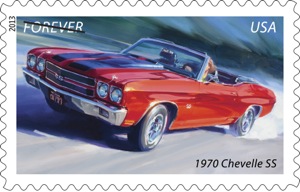
Fritz said he worked his way through college as a small-engine repairman, turning wrenches on lawn mowers and chain saws. At the same time, he was going through school, providing an abundant source of agitation for many teachers.
“I could hardly avoid turning my Pre-Calculus textbook into one of the longest animated flipbooks ever,” he said. “Or seeing how many different caricatures of my World History professor I could create in my notebook. “
He worked on the journalism staff in high school and college as a cartoonist, but it just wasn’t enough. Interpreting life, as he perceived through his art, was beginning to override the notion that he was going to be an engineer or scientist. “I really struggled with that,” he said, adding he was finally “shown the light.”
“Failing chemistry opened the door. I entered art school and never looked back.”
Upon graduating, Fritz began a 25-year tour of duty, which led up to his eventual position as staff artist for a Fortune 500 defense firm. Filling in slots as a freelance illustrator helped maintain his life’s responsibilities. And all the while, wherever and whenever possible, Fritz worked at developing his own interpretation of subject matter that interested him.
“Taking the common advice of my art instructors, ‘Paint who you are and what you know,’ my love of motor vehicles became my driving force,” he said.
From the early days of the Santa Monica Road Races, to the 1930s and ’40s when hot rods raced across the Mojave Desert, right up until today, Fritz investigates the history of automotive/motorcycle cultures so that he can present a realistic interpretation of my subject matter – an overview of the significance of the automobile/motorcycle in our lives.
“Today, I’ll occasionally take a break to hear the ping of a wrench hitting concrete in the garage, but admittedly, I still get my highest of highs in my studio.” 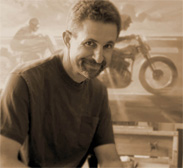
For more on artist Tom Fritz, visit his website at http://fritzart.com.












